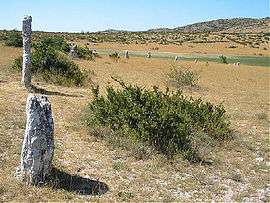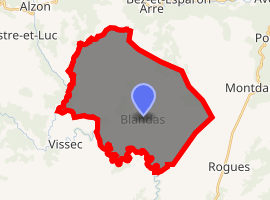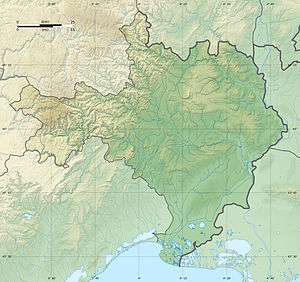Blandas
Blandas is a commune in the Gard department in southern France. It is known for its proximity to the Cirque de Navacelles and the town encompasses one of the principal overlooks on the Cirque. It is also known for its exceptional megalithic sites. It is included in the UNESCO world heritage site "The Causses and the Cévennes, Mediterranean agro-pastoral Cultural Landscape"[2][3]
Blandas | |
|---|---|
 Part of the Rigalderie stone circle in Blandas | |
.svg.png) Coat of arms | |
Location of Blandas 
| |
 Blandas  Blandas | |
| Coordinates: 43°54′49″N 3°30′49″E | |
| Country | France |
| Region | Occitanie |
| Department | Gard |
| Arrondissement | Le Vigan |
| Canton | Le Vigan |
| Intercommunality | Pays Viganais |
| Government | |
| • Mayor (2015-2020) | Jean-Claude Gonzalez Trique |
| Area 1 | 37.46 km2 (14.46 sq mi) |
| Population (2017-01-01)[1] | 135 |
| • Density | 3.6/km2 (9.3/sq mi) |
| Time zone | UTC+01:00 (CET) |
| • Summer (DST) | UTC+02:00 (CEST) |
| INSEE/Postal code | 30040 /30770 |
| Elevation | 280–953 m (919–3,127 ft) (avg. 650 m or 2,130 ft) |
| 1 French Land Register data, which excludes lakes, ponds, glaciers > 1 km2 (0.386 sq mi or 247 acres) and river estuaries. | |
Population
| Year | Pop. | ±% |
|---|---|---|
| 1881 | 528 | — |
| 1891 | 506 | −4.2% |
| 1901 | 420 | −17.0% |
| 1911 | 355 | −15.5% |
| 1921 | 268 | −24.5% |
| 1931 | 268 | +0.0% |
| 1936 | 227 | −15.3% |
| 1954 | 196 | −13.7% |
| 1962 | 172 | −12.2% |
| 1968 | 141 | −18.0% |
| 1975 | 115 | −18.4% |
| 1982 | 116 | +0.9% |
| 1990 | 112 | −3.4% |
| 1999 | 106 | −5.4% |
| 2008 | 128 | +20.8% |
History
Prehistoric Finds
La grotte des Pins
In may, 1967 a team of speleologues attempted to enlarge a natural opening exposed by erosion. Their work exposed a large hidden room 5m high and on the floor of the room they found fragments of ceramics. Further exploration uncovered tools, objects, and much scattered charcoal, up to 60 cm thick in places possibly from prehistoric torches. Theories at the time suggested that the cave served as a cellar or storage, rather than a habitation, since a lack of air circulation made hearth fires difficult.[4]
Baume du Roc du Midi
In 1979 at Baume du Roc du Midi, a cave which opens out from the cliff on the edge of the causse de Blandas at a lookout with a view over the Cirque de Navacelles, archeologists discovered a walled part of the cave, closed since the Middle Ages, but inhabited continuously from prehistory into protohistoric times. Inside the walled portion, many objects including two copper daggers with serrated blades, a bronze axe, a riveted bronze dagger, bronze sconces, spear-tips, and many other Bronze Age objects[5]
La Baumelle
A discovery was made in 2009[6] by speleologists in a prehistoric cave which had been blocked for over 5000 years. On August 10, 2009, speleologists, along with Laurent Bruxelles and Philippe Galant, from Institut national de Recherches archéologiques préventives, began a 10-day exploration of the find. The entrance was blocked by a menhir or stele. This sandstone monolith with engraved surface had been moved from a deposit found at Montdardier 5–6 km from the cave. Prehistoric remains were discovered: skulls, some covered in calcite, pieces of water-collecting vessels, ceramic shards, and a furnished hallway.[7]
Megaliths
see also Mégalithes du causse de Blandas (fr)
| Monument | Town | Note | Protection | Coordinates | Photo |
|---|---|---|---|---|---|
| Cromlech de Lacam de Peyrarines | Blandas | A prehistoric cromlech of 120m in diameter, including 50 standing stones of up to 1.8m high with a standing center menhir. Considered by many to be among the most impressive in Europe.[8][9] | 43.9261°N 3.5306°E |  | |
| Cromlech de Lacam de la Rigalderie | Blandas | A cromlech of approximately 90m in diameter with 36 stones, 20 of which are still upright, but lacking a central pillar. One menhir stands 2.5m high[10] | 43.9272°N 3.4914°E |  | |
| Cromlech de Lacam de Rogues | Blandas | 43.8942°N 3.5638°E | |||
| Dolmen d'Arques | Blandas | 43.9377°N 3.5032°E | |||
| Dolmen de Barral | Blandas | 43.9127°N 3.5541°E | |||
| Dolmen de la Borie d'Arre | Blandas | 43.8936°N 3.5367°E | |||
| Dolmen de Planas | Blandas | 43.9282°N 3.5366°E | |||
| Dolmen de Regos | Blandas | 43.9207°N 3.5427°E | |||
| Dolmen du Château d'Assas | Blandas | 43.9115°N 3.5374°E | |||
| Menhir d'Avernat | Blandas | 43.9357°N 3.4934°E | |||
| Menhir des Combes | Blandas | 43.9359°N 3.4958°E | |||
| Menhir de Planas | Blandas | other name Menhir du Serre de la Gleisa | 43.9266°N 3.5391°E | ||
| Menhir du Sotch des Genièvres | Blandas | 43.9262°N 3.5215°E | |||
| Menhirs de Landre | Blandas | 3 menhirs | 43.9365°N 3.5162°E | ||
| Menhirs du Travers des Noyers | Blandas | 2 menhirs | 43.9006°N 3.5207°E | ||

References
- "Populations légales 2017". INSEE. Retrieved 6 January 2020.
- Centre, UNESCO World Heritage. "The Causses and the Cévennes, Mediterranean agro-pastoral Cultural Landscape". UNESCO World Heritage Centre.
- "Accueil". Bienvenue à Blandas !.
- J.-L. Roudil et P. Vincent (1972). "La grotte des Pins (Blandas, Gard)". Bulletin de la Société préhistorique française (Etudes et Travaux, fascicule 2). 69. pp. 570–583.
- Documents préhistoriques de la grotte du Roc du Midi (Blandas, Gard) (article) J.-L. Roudil;P. Vincent; Bulletin de la Société préhistorique française Year 1974 vol71 n7 pp.203-209
- "Gard. La grotte aux miracles". ladepeche.fr.
- Galant, Philippe & Villemejeanne, Richard & Etienne, Aurélien & Bruxelles, Laurent & Boschi, Jean-Yves. (2012). 2015 - Découverte de deux stèles en contexte Néolithique final sur le site de la Baumelle à Blandas (Gard).
- https://www.megalithic.co.uk/article.php?sid=6334839
- "Cromlech de Perrarines".
- https://www.megalithic.co.uk/article.php?sid=6334837
| Wikimedia Commons has media related to Blandas. |